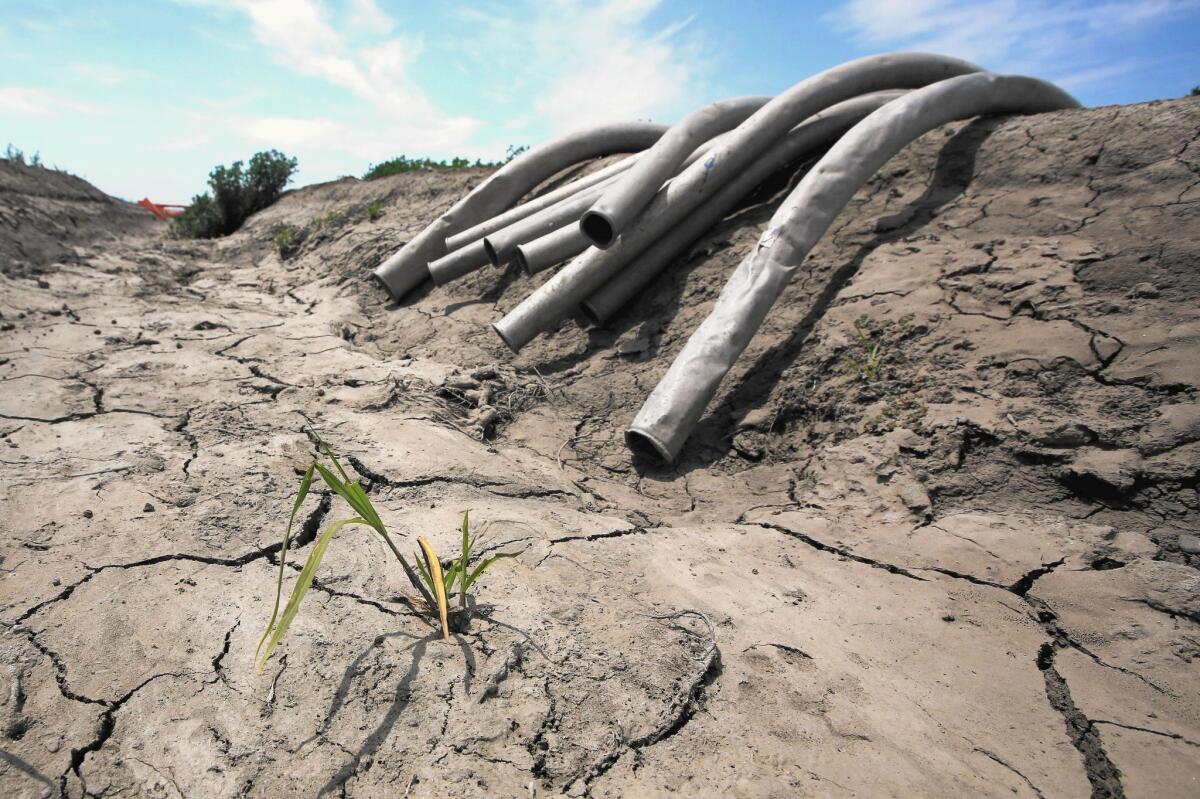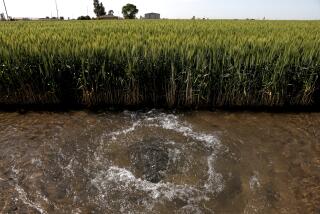Lawsuits over California water rights are a fight a century in the making

The lawsuits hit the courts within days of the state mailing notices to some Central Valley irrigation districts: They were to stop diverting from rivers and streams because there wasnât enough water to go around.
Unsurprising as the move may be in this fourth year of drought, to the districts, the notices amounted to an assault on water rights they have held for more than a century.
âThis is an attempted water grab,â said Steve Knell, general manager of the Oakdale Irrigation District, one of several San Joaquin Valley agencies suing the state to block the curtailments. âIt is a power move and we will fight tooth and nail to make sure that this doesnât happen.â
The drought has highlighted the arcane workings of Californiaâs water rights system, one that rewards those who got here first and underpins agricultureâs position as the stateâs dominant water user.
The irrigatorsâ rush to court shows how deeply entrenched the system is â and how any attempt to substantially remake it would encounter a legal and political minefield.
In California and much of the West, most rights to surface water are based on when flows were first diverted and used, a priority system known as âfirst in time, first in right.â The most senior rights predate 1914, when the state started to issue diversion permits. In times of drought, those with junior rights are cut off first to leave water for more senior diverters.
This year and last, the State Water Resources Control Board told thousands of junior rights holders in the Central Valley to stop drawing water from rivers and streams. Then on June 12, regulators reached further back, sending curtailment notices to more than 100 districts and growers with rights dating to 1903.
On Friday, it issued additional orders curtailing four of San Franciscoâs early 1900s rights as well as others that date to the mid-1800s. More are expected as flows continue to decline this summer.
Regulators had halted senior diversions once before, in the severe 1976-1977 drought. But it is unclear how widely those curtailments were enforced or whether any legal challenges were filed.
This time, irrigation districts lost no time challenging the state. They have already filed four separate lawsuits with multiple claims.
Chief among their arguments is that because California didnât start administering water rights until 1914, the state has no jurisdiction over pre-1914 rights. It is up to the senior rights holders themselves to enforce the rightsâ pecking order, the irrigators say, and the oldest districts have not complained that others are taking their water.
Moreover, the districts say the state hasnât fully enforced this yearâs junior curtailments: The state board revealed last week that compliance forms had been filed for about a third of the notices issued this year, the vast majority of which deal with junior rights.
âThe state ⌠is coming in trying to regulate people who cannot be regulated for the benefit of people who donât want to be regulated,â said attorney Steve Herum, who filed one of the lawsuits on behalf of the Banta-Carbona Irrigation District.
Federal and state agencies have in recent decades restricted senior diversions for environmental reasons: to protect imperiled fish and maintain water quality. But in many respects, senior diverters have been left alone. The state board doesnât even know how much water many of them are taking from Californiaâs rivers and streams.
Although reporting requirements have been on the books since 1966 and were beefed up by the Legislature in 2009, they have been largely ignored. According to the state board, a majority of senior rights diversions arenât being measured and reported, a fact that prompted lawmakers this month to again tighten the filing regulations.
âWater-use data in California is a huge problem,â said attorney Eric Garner, an adjunct professor of water law at USC. âYou cannot manage a resource without data.â
The lack of good diversion information raises the question of how the state board can determine what rights to curtail and when. âWe know well enough from the reports we get and from other estimates available,â said Andrew Sawyer, the state boardâs assistant chief counsel. âWe definitely could use better data.â
Sawyer called the lawsuits premature, because the curtailments are technically notices, not orders. But if the districts continue to withdraw water, the board could issue enforcement orders, subjecting diverters to steep fines and even court prosecution.
âThis is about diverting when thereâs no water available under your water right priority,â Sawyer said. âWhat the water board is trying to do is implement the priority system.â
He cited three recent court cases, unrelated to the drought, in which diverters challenged the boardâs oversight of pre-1914 rights, as well as riparian rights, under which landowners can pump supplies from streams and rivers flowing by their property. âThe water board won all three,â Sawyer said.
Although some Northern California cities have senior rights, irrigation districts and growers hold far more. That mismatch of water and population has led some to suggest it is time to revamp a rights system that dates to the Gold Rush. They point to Australia, which recently overhauled its water rights after a devastating drought.
But legal experts donât see any radical changes on the horizon.
âI donât think the water rights system is going to be blown up this year or any time soon,â said Holly Doremus, a UC Berkeley law professor of environmental regulation.
âIâve always thought the people who say, âLetâs just become Australiaâ â thatâs incredibly naive,â she said. âBecause it would require extraordinary political changes and because they didnât have the property rights protection that we do. It would be such a mess in terms of takings claims.â
Still, mounting pressure on Californiaâs water supply will inevitably turn more attention to how and by whom water is used in the nationâs most populous state.
âNo water right is set in stone,â Garner said. âI think that all water rights and all water users are going to be getting greater scrutiny.â
The most likely vehicle for that scrutiny is Article X, Section 2 of the California Constitution, a core principle of state water law that says every water use must be reasonable and beneficial. The state Supreme Court has ruled that what is considered beneficial can change with conditions.
Citing that provision, the state board this month approved an emergency drought regulation that includes a ban on watering lawns in the watersheds of four creeks that feed into Northern Californiaâs Russian River. The prohibition is intended to reduce water use â and thus diversions and well withdrawals â that is diminishing stream flows crucial to the survival of endangered Central California Coast coho salmon and steelhead trout.
The board âis starting to say certain kinds of uses are unacceptable, even if you hold senior rights, at least under dry conditions,â Doremus said.
âI think every time the board says these specific things are not reasonable uses of water, they are waste â I think ⌠they become more likely to do it again,â she said.
Twitter: @boxall
More to Read
Sign up for Essential California
The most important California stories and recommendations in your inbox every morning.
You may occasionally receive promotional content from the Los Angeles Times.











